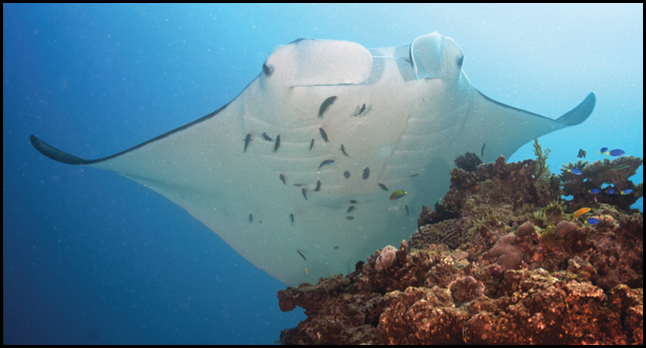White-tips

Beez Neez now Chy Whella
Big Bear and Pepe Millard
Thu 9 May 2013 22:57
|
Snorkelling with Mantas and
White-Tipped Sharks
We left the lava tunnels and found loads
of manta rays taking the sun. I took this shot just
before we got in to swim with them, my camera was out of its cover so I left it
behind. Massive, graceful and oddly beautiful. Sadly Bear thought he had his
camera switched on and clicking away as a huge swimming carpet swam below him.
Never mind. The experience was surreal. I was talking to our guide when a giant
took off, was a full two feet above the surface and splashed down. The guide was
standing right in front of Bear so he missed it. Mmmm.
A manta in Okinawa Churaumi
Aquarium
These pictures are with grateful thanks to
Wikipedia. Manta rays are large eagle
rays belonging to the genus
Manta. The larger
species, M.
birostris, reaches twenty six feet in width while
the smaller, M.
alfredi, reaches eighteen feet. Both have
triangular pectoral
fins, horn-shaped cephalic fins and large,
forward-facing mouths. They are classified among the Elasmobranchii (sharks and rays)
and are placed in the eagle ray family
Myliobatidae.
 Manta visiting a cleaning
station.
Mantas can be found in temperate, subtropical and tropical waters. Both species are pelagic; M. birostris migrates across open oceans, singly or in groups, while M. alfredi tends to be resident and coastal. They are filter feeders and eat large quantities of zooplankton, which they swallow with their open mouths as they swim. Gestation lasts over a year, producing live pups. Mantas may visit cleaning stations for the removal of parasites. Like whales, they breach, for unknown reasons.
A gentle giant feeding
Both species are listed
as Vulnerable by the International Union
for Conservation of Nature. Anthropogenic threats
include pollution, entanglement in
fishing
nets, and direct harvesting for their
gill
rakers for use in Chinese
medicine. Their slow reproductive rate
exacerbates these threats. They are protected in international waters by the
Convention on
Migratory Species of Wild Animals, but
are more vulnerable closer to shore. Areas where mantas congregate are popular
with tourists. Only a few aquariums are large enough to house them. In general, these large
fish are seldom seen and difficult to study. We were very lucky
indeed.
Our next stop was amongst a mangrove area
in shallow water. We were hoping to see white-tips. We swam up behind this little chap but as he slid in it was quite clear he was
going at just the one speed – like a rocket.
It wasn’t too long before we saw a white-tip but he shot into a
dark cave.
A Galapagos ray
ambled by.
Lots of fish to
see and the tell-tale white markings in the distance.
Missed. Too late
as this this takes a turn behind a rock.
Oops, chopped his tail
off.
They have the gills and
beady eyes of their relatives but are quite shy.
.
ALL IN ALL WHAT AN
EXPERIENCE |
